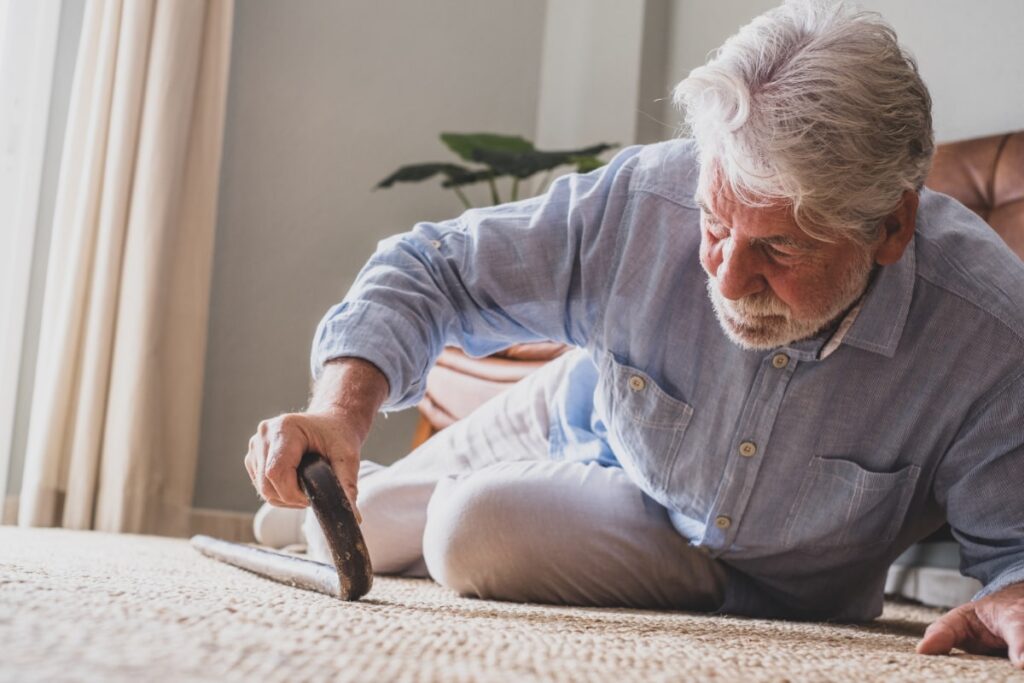Do you find yourself dreading stairs, even fearful of them? Do you wish you could comfortably negotiate stairs like you used to rather than just relying on your strongest leg? This post presents stair negotiation exercises – both for going up stairs as well as going down stairs. These exercises will improve your stair negotiation ability – at home, while shopping or visiting family. You will feel safer in your own home and everywhere you travel.
Over my forty years of work as a Physical Therapist, I have helped hundreds of individuals recover from surgery, car accidents, and de-conditioning. The key is to rebuild their strength and confidence. It can take a little training, breaking old habits, learning new ones but everyone succeeds and you will too!
Stair Negotiation Exercises
A lot of my clients have either moved into single level bungalows or retirement homes with elevators. They might have to step up onto a sidewalk or the entrance into their homes, but rarely encounter a set of stairs.
As a result, they haven’t negotiated stairs in a long time. When they visit families in multi-story homes, attend appointments in buildings with stairs, they are surprised by the challenge of climbing or descending a set of stairs.
These are big issues for them. They haven’t done an eight inch step in a while and they soon experience knee and hip pain. They are often fearful of losing their balance and falling.
Today I will show you how to get back to doing steps, feel safe and strong enough to negotiate stairs, and regain your confidence.

Exercise to Easily Negotiate Going Down Stairs
Going down stairs, as you know, can be difficult and scary. Stair negotiation is more challenging going down stairs than going up stairs.
Why is that?
Going down stairs requires your legs muscles to control the lowering of each leg. This is an eccentric contraction, the most demanding type of muscle contraction. Going up stairs is a concentric contraction and is much easier and less demanding on the leg muscles.
To master going DOWN stairs, you will build up to doing this controlled lowering, eventually on just one leg. I show you a step wise progression in the video below.
Start With 50% Of Your Weight On Each Leg
Start with fifty percent of your weight evenly distributed on each leg. Follow these steps as demonstrated in the video:
- Stand tall with your feet hip width apart.
- Use a stool, a stacked pillow on your sofa, or a tall bed to practice from.
- Take a relaxed breath in.
- Exhale and slowly lower yourself into the chair. Keep your knees over your feet.
- Exhale through the move. It will help give you more core stability and balance and help reduce the fear or anxiety your body may be feeling. No need to go very deep.
The range you need for stairs is about half of what you need when sitting on a chair.
- Start with three to five repetitions.
- Build an extra repetition every other day until you can comfortably do ten repetitions.
The goal is to build your strength gradually so as not to flare up any joints and to allow all the muscles around your hips and knees to strengthen.
Gradually Increase The Amount of Your Weight You Support on One Leg
Work towards being able to hold all your weight on one leg. It may take a few weeks to build the strength, but you will get stronger and the stairs will get easier to negotiate.
Place a sturdy chair in front of the surface you have been working from, then stagger your feet so that you can feel 60% of your weight going through the back foot and 40% on the front.
In the video, I place a second chair in front of me. Behind me is the other chair. This position is secure so I am now able to stagger my stance and distribute my weight. I start with a 60/40 weight distribution and build from there.
- Do five on each leg.
- Gradually build to ten on each leg.
- Some of you may be able to add more weight faster than others. You are all unique and will progress at the pace that you can.
- When it starts to feel easier, place seventy percent of your weight on your back leg.
- Every other day gradually add a little more weight onto your back leg.
- Slowly over time build to ten repetitions on each leg.
Using the railing will allow you to take up the weight that you are not able to control on one leg. As you get stronger and able to control more of your weight through your knees, you will be able to rely less on the railing.
Exercise Recommendations for Osteoporosis
Exercise is an essential ingredient to bone health. If you have osteoporosis, therapeutic exercise needs to be part of your osteoporosis treatment program.
But what exercises should you do and which ones should you avoid? What exercises build bone and which ones reduce your chance of a fracture? Is Yoga good for your bones? Who should you trust when it comes to exercises for osteoporosis?
A great resource on exercise and osteoporosis is my free, seven day email course called Exercise Recommendations for Osteoporosis. After you provide your email address, you will receive seven consecutive online educational videos on bone health — one lesson each day. You can look at the videos at anytime and as often as you like.

I cover important topics related to osteoporosis exercise including:
- Can exercise reverse osteoporosis?
- Stop the stoop — how to avoid kyphosis and rounded shoulders.
- Key components of an osteoporosis exercise program.
- Key principles of bone building.
- Exercises you should avoid if you have osteoporosis.
- Yoga and osteoporosis — should you practice yoga if you have osteoporosis?
- Core strength and osteoporosis — why is core strength important if you have osteoporosis?
Enter your email address and I will start you on this free course. I do not SPAM or share your email address (or any information) with third parties. You can unsubscribe from my mail list at any time.
Five Simple Tips to Easily Negotiate Going Up Stairs
If you have knee pain, feel unstable, or feel winded by the time you reach the top of the stairs, the following five tips will help you with all of these. I cover these in my video below:
Follow these steps:
- Start with a smaller step height to practice the new technique and gain confidence.
- When possible, place your whole foot on the step.
- Keep your knee over your foot and not in front of it, nor to the side of it.
- Bring your butt back and bend from your hips. This sets up your strongest leg muscle, your buttocks, to do more of the work. Take a breath in …
- Exhale through pursed lips as you PUSH the STEP away from you, bringing your hips forward. Feel the tightening in your butt muscles.
Breath Control and Stair Negotiation
The exhalation with the effort will help you recruit your core muscles and make you more stable.
Coordinating your breath will also ensure you’re not holding your breath. You will not be out of breath by the time you reach the top. Your body will interpret your breathing and know that you are in control!!
Practice this with the support you need to feel safe and secure as you regain confidence in your legs. Once you have mastered a three to four inch step, you are ready to go to a full sized step.
Stair Negotiation: Strengthen Your Lower Body
Stronger legs (and lower body) will make stair negotiation much easier. You can supplement the two routines above with some simple leg strengthening exercises. The video below includes three leg strengthening exercises for beginners.
My strength training guide is an excellent resource as well.
Stair Negotiation: Improve Your Balance
Good balance and stability will increase your safety and help you go up and down stairs with more confidence. The two balance exercises in this video are designed to help you improve your balance.
My balance and fall prevention guide is an excellent resource as well.
Stair Negotiation: Posture
Posture influences everything – your balance, your strength, flexibility, and agility. As a result, postural alignment has a significant effect on stair negotiation. Here are two posture exercise videos you can use to improve your posture. My Posture Guide is another great resource.
Stair Negotiation Exercises in the Pool
Some of my clients are lucky enough to live in condominiums where there’s a pool. The pool will have stairs going down into the water.
If you start on the stairs that are in the water, the buoyancy of the water will help lift up your body weight and will help you do the steps. This technique allows you to start right away with a six inch step or seven inch step.
Start with the water at chest height and then progress to a higher step so that the water is eventually at hip height. The water buoyancy will gradually support more of your body weight on the step.
Extra Safety Tips
Here are a few tips that will make your stair negotiations much safer:
- Use handrails to provide support and stability.
- Wear footwear that is stable and provides good traction.
Poor control with stairs is often an indicator of overall de-conditioning. Follow a safe and progressive exercise program that helps you regain your strength.
Conclusion
Physical therapy exercises for stair negotiation can transform your relationship with stairs from one of anxiety to confidence. By following the progressive stair negotiation exercises outlined in this post—practicing controlled lowering for descending stairs, mastering the five tips for ascending stairs, and even utilizing pool exercises when available—you can rebuild the strength and technique needed for safe stair negotiation.
Remember that everyone progresses at their own pace. What matters most is consistency and gradually building strength without flaring up your joints. With practice, you’ll find yourself relying less on handrails and feeling more secure in your movements.
Whether you’re visiting family in multi-story homes or navigating public buildings, the exercises and techniques shared here will help you move with greater ease and confidence. As I’ve seen with hundreds of clients over my forty years as a Physical Therapist, everyone can succeed with the right training—and you will too!
Don’t let fear of stairs limit your independence or quality of life. Start with these exercises today, be patient with yourself, and soon you’ll be negotiating stairs safely wherever life takes you.






Comments